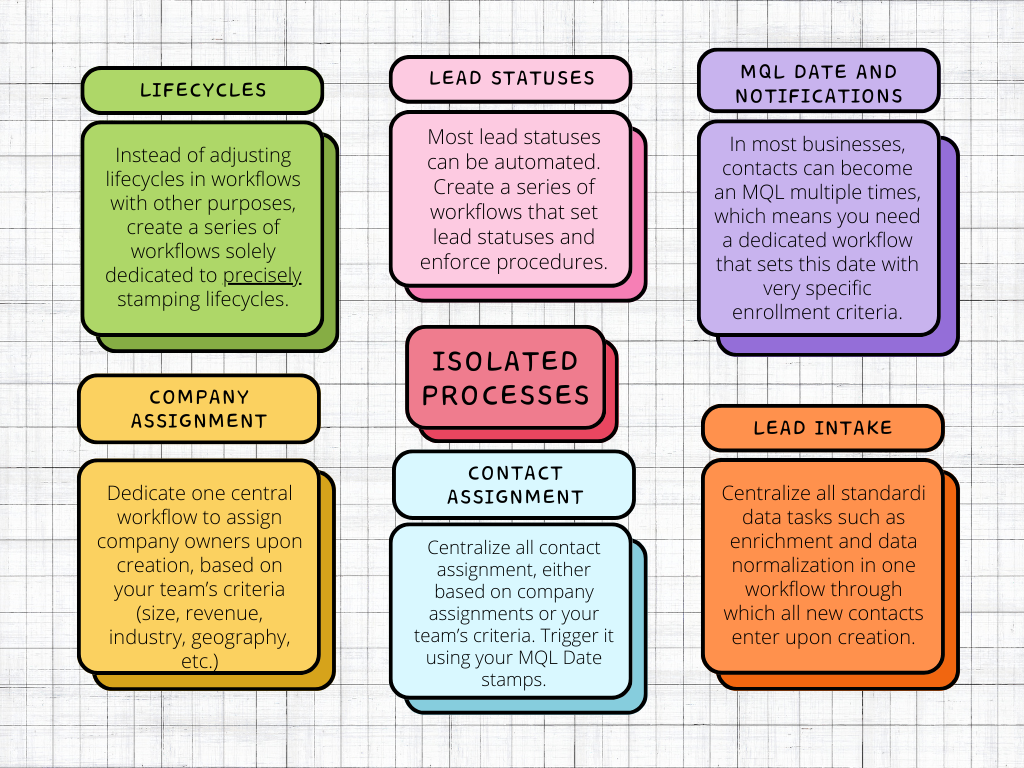When I first started working out of marketing automation platforms like HubSpot over a decade ago, I took a very deliberate, simplistic approach. Workflows are powerful and I didn't want to overcomplicate things by trying to do too many functions in one workflow.
Then as I gained more experience, combining things into the fewest amount of workflows became a point of pride. I could put together an entire webinar in one workflow - emails invites to a large portion of the database, instant registration confirmations, reminders, post-event follow-ups, scoring adjustments and SFDC campaigns all in one massive, winding workflow.
It was impressive, efficient, and wildly unnecessary. The smallest mistake in logic or enrollment criteria would send thousands of people down the wrong path. Admittedly, it was a bit of hubris on my part.
With HubSpot you have two options when it comes to workflow strategies:
- Build a select few number of workflows that each contain a multitude of functions
- Build a lot of specific-purpose workflows, with a handful of workflows that serve global, centralized functions
Today, I recommend doing a little bit of both to my Hubspot consulting clients. Complex workflows that contain a multitude of functions are okay in a lot of scenarios - but there are a number of operations that absolutely, positively should only happen in one focused workflow.
Read on to learn what those are.

Which Processes Should Have Dedicated HubSpot Workflows?
Nothing is more sacred than clean data and a big portion of that is knowing where important aspects are being manipulated. The places that manipulate those fields should be sacred, locked down like Fort Knox, and extremely predictable.
The following processes are global functions that have other processes and fields that are co-dependent upon them. They require cross-team agreement and are critical to segmentation and reporting.
In other words, these processes only occur in one place, and that place shall not be messed with.
Contact and Company Assignment
It can be tempting to have multiple workflows that handle assignment. Sales teams might have sales specialists for specific topics, so it's tempting to include lead routing on a workflow that fulfills a form submission for a specific piece of content.
But what happens when an existing client fills out the form? What about a new contact from an existing client? What if someone binges a lot of your content, and their Contact Owner is whipping around your sales team like a drunken ballroom dancer?
Avoid this. Contact assignment is sacred and should only happen in one, centralized workflow. This workflow can be complex, since it should account for existing clients vs prospects, regional assignments, specialties, nurture vs hand-raisers, and so on.

Lifecycle Adjustments
HubSpot gives you a lot of options for lifecycle manipulation. You can set it based on specific form submissions. You can sync it up with the Company lifecycle. You can have it automatically set based on deal outcomes. You can adjust it via workflows, or just outright manual manipulation (you'd be surprised at how many companies use it as a de facto lead status field).
Don't! I recommend going even more granular and setting up dedicated workflows for each lifecycle stage. There are few things worse than a Lead that doesn't get bumped to MQL when it should, or even worse, a lead that accidentally moves to MQL, only to get sales hot and bothered for nothing.
Marketing Qualified Lead Date
I just mentioned not trying to outsmart the baked-in Lifecycle Stages HubSpot comes with out of the box. The one exception to that is Marketing Qualified Lead. The reality in B2B sales is leads can MQL multiple times. The new Leads feature in HubSpot tries to address this but it still isn't quite dialed in.
So, what I recommend is building an MQL Date field that can be updated based on your specific criteria. But I don't include it in my regular lifecycle stage workflow because, in my system and others, a contact can become a Marketing Qualified Lead while also being in a Lifecycle Stage that isn't Marketing Qualified Lead.
At this point I want to reiterate that Lifecycle Stage is a representation of where a person or company is in your funnel. A new contact from an existing client can fill out a Contact Us form and MQL while also having a Lifecycle Stage of Customer.
A former client (who would be in Lifecycle Stage = Customer) can MQL. An Opportunity that was Closed-Won can accrue points in a nurture program and be designated an MQL months, or even years after their first go-round as an MQL.

The point being, there's enough unique criteria and circumstances to merit MQL Date being its own workflow. Then, when MQL Date is equal to today, that triggers sales assignment and follow-up notifications.
Every company is a little bit different, but the paths to becoming a Marketing Qualified Lead usually include:
- Anyone who fills out a contact us form
- Anyone who begins a free trial of your software
- Prospects and former clients who cross the engagement points threshold
- Current clients who take a high intent action, like attending a product webinar or scanning a badge at your tradeshow booth
Lead Status
Like Lifecycle Stages, Lead Status is an important component of segmentation and you should have some strict rules of engagement around when lead status can be updated and when it cannot.
You could set a content-fulfillment workflow to set a lead status as something like "Ready for Follow-up" but what if the lead has already been set to "Disqualified" by your sales team?
The point of this one, like all of the others, is Lea Status is a very specific value that's independent of most other actions in your CRM. It doesn't matter if the person has filled out 100 content forms, if they're already disqualified, or if sales is already reaching out to them (represented by a status of "Contacting") - lead status is an independent process that should only be updated in one central spot, or in a series of workflows dedicated to setting specific values.
Lead Intake
Think of that as the front door through which every lead must enter your database. Everyone has essential processes, such as company lookups, enrichment and validation, and so on. It can be temping to do this in every form-based workflow, but by doing so you risk reverting certain items and wasting money by pushing contacts to the same services. Do this is one place so that every newly created contact goes through it exactly once.
Of course, it goes without saying that you might want this workflow to also do some lifting for the lifecycles, lead statuses and assignments - don't! Let those processes sit alone and do their things, and avoid the temptation to be overly complex in what should be a global service process.
Important Processes Deserve Dedicated Workflows
I don't know how to sum it up any more succintly than that. I know it stinks to manage a ton of bite sized workflows, especially if you're like a lot of HubSpot admins and have multiple roles to fill.
The good news is once you nail down the specific criteria for each of these processes, you really don't have to manage them much. Definitions for lifecycles, lead statuses, and MQLs shouldn't change very often. Company and contact assignments will change because sales teams have high turnover, but that's one area that worth the pain of accuracy. (And if you work in marketing, this is worth the investment to build the relationship with your sales team AND ensure your precious MQLs go to the right loving arms)
Predictability and accuracy are always worth the effort. Few things are harder than unwinding data processes gone awry, whether it impacts 10 records or 10,000. Remember to treat these important processes with the utmost care and create dedicated workflows for each of them.
Feb 7, 2024 9:06:02 PM



